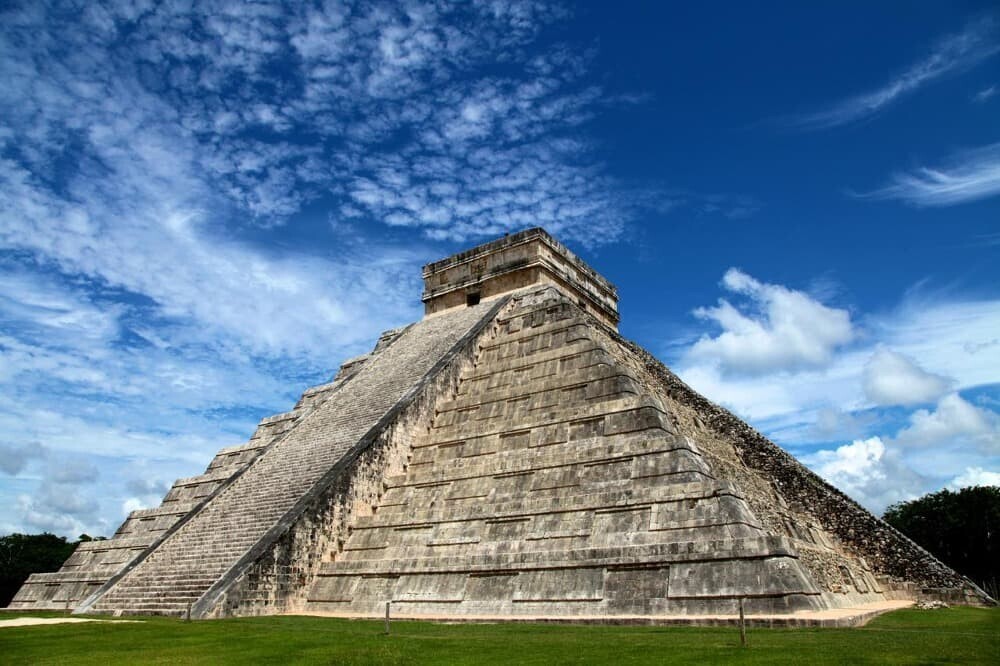Mexico is a country located in North America, bordered to the north by the United States, to the south and west by the Pacific Ocean, to the southeast by Guatemala, Belize, and the Caribbean Sea, and to the east by the Gulf of Mexico.
With a rich and diverse history, spanning from ancient Mesoamerican civilizations like the Maya and Aztecs to its independence from Spain in 1821.
Today we are talking about one of the wonders of the world located in the Yucatán Peninsula, known worldwide for its history, Chichen Itza. So you can visit it if you choose this destination for your volunteer experience.
Its history dates back to pre-Columbian times and covers several centuries of cultural, political, and religious development.
- 6th – 7th Century: Chichen Itza was founded during this period, during the Early Classic period. Its name means “Mouth of the well of the Itzaes” in Maya. During this phase, some of the first structures were built, influenced by the Puuc culture, such as the Temple of the Warriors and the Ball Court.
- 10th – 13th Century: Chichen Itza reached its peak during the Early Postclassic period, becoming a political, religious, and commercial center. Toltec influence is evident in the architecture and art of this period. The pyramid of Kukulcán, also known as El Castillo, is one of the most iconic buildings of Chichen Itza. This temple was dedicated to the feathered serpent, Kukulcán.
- 13th – 14th Century: Chichen Itza began to decline, possibly due to internal conflicts, resource depletion, or climatic changes. The city was gradually abandoned.
- 16th Century: When Spanish explorers arrived in the Yucatán Peninsula, they found the ruins of Chichen Itza. However, they remained largely intact until restoration work
- in the 19th and 20th centuries. In the late 19th century, archaeologists like John Lloyd Stephens and Frederick Catherwood documented and studied the city. In the 20th century, institutions such as the National Institute of Anthropology and History (INAH) and Harvard University carried out excavations and restorations.
In 1988, Chichen Itza was declared a World Heritage Site by UNESCO due to its historical, cultural, and architectural importance, and in 2007, the pyramid of Kukulcán was named one of the New Seven Wonders of the World, further increasing its global recognition.
Today, Chichen Itza is a major tourist site and a symbol of the rich cultural heritage of the Maya. It attracts millions of visitors every year, who come to admire its monumental architecture and learn about the history of one of the most advanced civilizations in Mesoamerica.

SOME CURIOSITIES
During the spring and autumn equinoxes, sunlight creates a shadow effect on the north staircase of the pyramid of Kukulcán that resembles a serpent descending. This astronomical phenomenon is a testament to the precision with which the Maya aligned their structures with celestial events.
2. The Great Ball Court
The ball court in Chichen Itza is the largest in Mesoamerica, measuring 168 meters in length. The game had ritual and political connotations, and sometimes human sacrifices were performed as part of the ritual.
3. The Sacred Cenote
The Sacred Cenote was used for human sacrifices and offerings to the gods. During excavations, human remains and valuable objects such as jade, gold, and ceramics have been found at the bottom of the cenote.

4. The Acoustics of El Castillo
The pyramid of Kukulcán has surprising acoustics. If someone claps in front of the staircase,
the sound that is heard resembles the song of a quetzal, a sacred bird in Maya culture.
5. El Caracol Observatory
The observatory, known as El Caracol due to its internal spiral staircase, was used to study the movements of Venus and other celestial bodies. Its design allows for precise astronomical observations.
6. The Temple of the Warriors and the Group of a Thousand Columns
The Temple of the Warriors is famous for its rows of columns carved with images of warriors.
These columns supported what is believed to have been a roof of wood and thatch.
7. Chichen Itza in Popular Culture
Chichen Itza has appeared in numerous movies, books, and video games. Its worldwide fame has made it a representative icon of the ancient Maya civilization.
For the ancient Maya, Chichen Itza was an important place of pilgrimage and religious ceremonies. Rulers and elites came here to participate in rituals and consult with priests. And today it remains one of the most visited places in Mexico.
It is a must-see on your trip.
Mexico awaits you.




